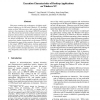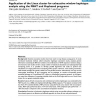420 search results - page 2 / 84 » Dynamic program analysis of Microsoft Windows applications |
ISCA
1998
IEEE
13 years 9 months ago
1998
IEEE
This paper examines the performance of desktop applications running on the Microsoft Windows NT operating system on Intel x86 processors, and contrasts these applications to the p...
ISSTA
2010
ACM
13 years 8 months ago
2010
ACM
Whitebox fuzzing is a novel form of security testing based on dynamic symbolic execution and constraint solving. Over the last couple of years, whitebox fuzzers have found many ne...
BMCBI
2008
13 years 5 months ago
2008
Background: Genetic association studies have been used to map disease-causing genes. A newly introduced statistical method, called exhaustive haplotype association study, analyzes...
ACSAC
1999
IEEE
13 years 9 months ago
1999
IEEE
Many security breaches are caused by inappropriate inputs crafted by people with malicious intents. To enhance the system security, we need either to ensure that inappropriate inp...
POPL
2010
ACM
14 years 2 months ago
2010
ACM
Program analysis tools typically compute two types of information: (1) may information that is true of all program executions and is used to prove the absence of bugs in the progr...


